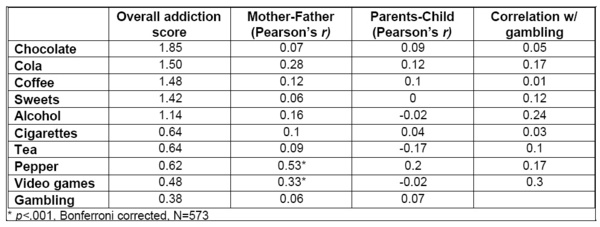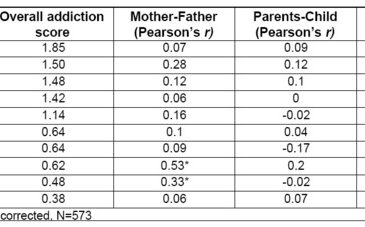The moniker “addiction science” implies an inherent qualitative unity among the various addictions. But what, if any, empirical relationships support such a unified approach? Rozin and Stoess (1993) set out to explore this question using a sample of college students and their parents (n=573). In addition to looking at major DSM-IV defined substances of abuse (e.g., alcohol, caffeine, nicotine) and gambling. The authors included other common cravings (e.g., hot chili pepper, sweets, and video games). Students and their parents completed questionnaires that measured four distinct components: craving, withdrawal, lack of control, and tolerance. Craving was defined as “a strong desire occuring at least a few times a month.” Withdrawal involves the “presence of physical discomfort resulting from…abstaining from the activity of concern.” Lack of control is considered a “difficulty in stopping the consumption of the indicated substance or the indicated activity.” Tolerance “means that individual doses of the substance or activity in question produce less of an effect than they used to.” Composite addiction scores were computed and placed on a scale of one to eight, with eight indicating a high level of addiction.

For this sample of Ivy League students and their parents, the mean severity of gambling addiction was lower than any other substance or activity addiction. This should not be surprising given the expected lower prevalence of gambling when compared to chocolate and alcohol consumption. What was surprising, however, was that no significant correlation was found between the tendencies of mothers and fathers to be addicted to gambling. Similarly, no relationship existed between the addiction tendency of parents and that of their children. A moderate positive correlation was found between addiction scores for gambling and scores for addiction to video games. The authors attribute this relationship to the overlapping qualitative nature of the two activities.
Is there indeed unity among the addictions? The data provided by Rozin and Stoess is inconclusive, and the authors suggest caution when speaking of a single, unified tendency toward addiction.
Source: Rozin, P., and Stoess, C. (1993). Is there a general tendency to become addicted? Addictive Behaviors, 18, 1, 81-87.
This public education project is funded, in part, by The Andrews Foundation and the National Center for Responsible Gaming.




